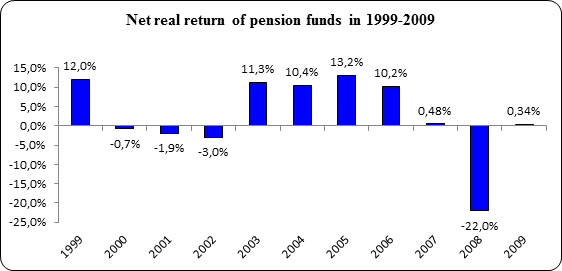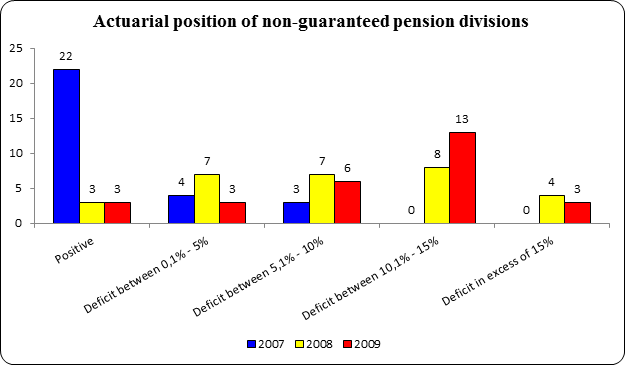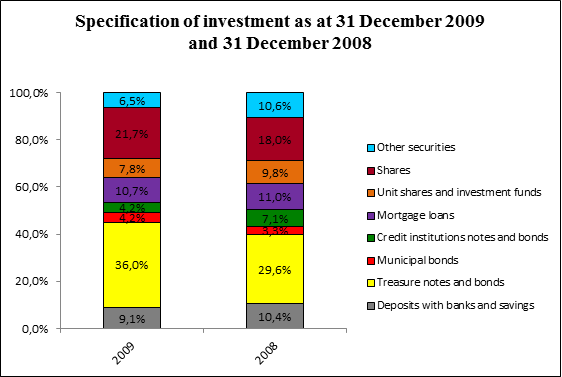Status of pension funds in 2009
A report containing information from the annual financial statements of pension funds for the year 2009 is available at the Financial Supervisory Authority‘s (FME) webpage. There is also an excel file that contains statistical information from the report. The main results of the report are the following:
The real rate of return is 0.34% above the consumer-price index, as compared to -21.96% in 2008. The five-year average is 0.4%, and the ten-year average is 1.8%. The low real rate of return can be attributed to the aftermath of the bank crises in 2008. High inflation, corporate bond write-offs and currency restrictions characterized last year.

The report shows that net assets for pension payments amounted to almost ISK 1,775 billion at year-end 2009, as compared to ISK 1,600 billion at the same time in t 2008. This corresponds to an annual increase of 11%, or a positive real return of 2.2% as measured above the consumer price index.
Premiums decreased between years from ISK 114 billion in 2008 to ISK 107 billion in 2009. This corresponds to an annual decrease of 9%. The main reason for this reduction is considered to be the increased unemployment and generally lower wages in 2009. Pensions with the interim provision regarding disbursement of private pension, in the year 2009 amounted to ISK 76 billion, as compared to ISK 54 billion in 2008.
Private pension savings deposited with pension funds and other depositories amounted to ISK 288 billion at year-end 2009, as compared to ISK 256 billion at the same time in 2008. This corresponds to an annual increase of 12.8%. Private pension savings in total amounted to approximately 15% of the total assets of the entire pension system at year-end 2009. Private pension savings premiums decreased and totalled ISK 33.4 billion in 2009, as compared to ISK 26.3 billion in 2008.
According to Act 129/1997 on the Mandatory Guarantee of Pension Rights and the Operations of Pension Funds, the assets of a pension fund together with the present value of future premiums shall equal the present value of estimated pension payments. All pension funds showing a deficit of 10% or higher, as calculated by annual actuarial survey, must amend their articles of association in order to achieve a balance. Any fund showing a negative position ranging from 5%-10% for a period of 5 consecutive years must also change its articles of association to regain equilibrium. On 21 December 2009 a transitional provision was extended which authorized pension funds to maintain up to a 15% difference between the assets and present value of estimated pension payments based on actual valuation for the year 2009 without amending their articles of associations. At year-end 2009 the position of 22 non-guaranteed mutual funds out of a total of 25 was negative; three funds had a deficit in excess of 15%. The only exemption from this provision is in the case of funds that are guaranteed by the state or municipal authorities. The balance of guaranteed pension funds is similar between years, and almost all of the divisions show a significant deficit.

This year a new chapter on pension funds' actuarial positions has been added to the report. The chapter is based on data gathered from an actuarial survey conducted in December 2009 and includes both the accrued position and future actuarial position of pension funds. In addition is the chapter contains numerical data on premiums and pensions, active members and pensioners.
About 7.4% of pension funds' investments were in non-listed securities at year-end 2009, as compared to 8.6% at the same time in 2008. According to Act No. 129/1997 pension funds are permitted to invest a maximum of 10% of their assets in non-listed securities. Non-listed securities, as defined in Article 36, are securities that do not have a posted buying and selling rate on a regulated market.
On 29 December 2008 the permitted maximum investment in unlisted securities was increased to 20%. Foreign currency exposures totalled 30% at year-end 2009, as compared to 29% at year-end 2008.
The chart below shows the structure of the pension funds' portfolio assets as at 31 December 2009 and 31 December 2008. The columns shows, holdings in other securities have decreased between these periods and Treasure notes and bonds have increased. The main reason for this is considered to be worse position of domestic companies and limited investment opportunities due to currency restrictions. Pension funds have written off a part of their investment in credit institutions and corporate notes and bonds. In addition they have moved part of their investments to Treasure notes and bonds.

The report will only be available on FME‘s website. Material may be reproduced from this publication but an acknowledgement of source is requested.
Annual Accounts and Diverse Figures 2009
Tables from Annual Accounts 2009
For further information contact Sigurður G. Valgeirsson, sgv@fme.is, telephone: 520-3700 and mobile phone: 840-3861